Chromatin features, RNA polymerase II and the comparative expression of lens genes encoding crystallins, transcription factors, and autophagy mediators
- PMID: 26330747
- PMCID: PMC4551281
Chromatin features, RNA polymerase II and the comparative expression of lens genes encoding crystallins, transcription factors, and autophagy mediators
Abstract
Purpose: Gene expression correlates with local chromatin structure. Our studies have mapped histone post-translational modifications, RNA polymerase II (pol II), and transcription factor Pax6 in lens chromatin. These data represent the first genome-wide insights into the relationship between lens chromatin structure and lens transcriptomes and serve as an excellent source for additional data analysis and refinement. The principal lens proteins, the crystallins, are encoded by predominantly expressed mRNAs; however, the regulatory mechanisms underlying their high expression in the lens remain poorly understood.
Methods: The formaldehyde-assisted identification of regulatory regions (FAIRE-Seq) was employed to analyze newborn lens chromatin. ChIP-seq and RNA-seq data published earlier (GSE66961) have been used to assist in FAIRE-seq data interpretation. RNA transcriptomes from murine lens epithelium, lens fibers, erythrocytes, forebrain, liver, neurons, and pancreas were compared to establish the gene expression levels of the most abundant mRNAs versus median gene expression across other differentiated cells.
Results: Normalized RNA expression data from multiple tissues show that crystallins rank among the most highly expressed genes in mammalian cells. These findings correlate with the extremely high abundance of pol II all across the crystallin loci, including crystallin genes clustered on chromosomes 1 and 5, as well as within regions of "open" chromatin, as identified by FAIRE-seq. The expression levels of mRNAs encoding DNA-binding transcription factors (e.g., Foxe3, Hsf4, Maf, Pax6, Prox1, Sox1, and Tfap2a) revealed that their transcripts form "clusters" of abundant mRNAs in either lens fibers or lens epithelium. The expression of three autophagy regulatory mRNAs, encoding Tfeb, FoxO1, and Hif1α, was found within a group of lens preferentially expressed transcription factors compared to the E12.5 forebrain.
Conclusions: This study reveals novel features of lens chromatin, including the remarkably high abundance of pol II at the crystallin loci that exhibit features of "open" chromatin. Hsf4 ranks among the most abundant fiber cell-preferred DNA-binding transcription factors. Notable transcripts, including Atf4, Ctcf, E2F4, Hey1, Hmgb1, Mycn, RXRβ, Smad4, Sp1, and Taf1 (transcription factors) and Ctsd, Gabarapl1, and Park7 (autophagy regulators) have been identified with high levels of expression in lens fibers, which suggests specific roles in lens fiber cell terminal differentiation.
Figures



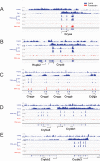
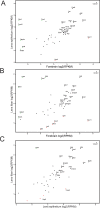
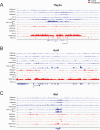
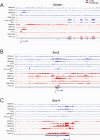
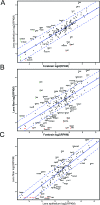
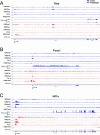

Similar articles
-
Profiling of chromatin accessibility and identification of general cis-regulatory mechanisms that control two ocular lens differentiation pathways.Epigenetics Chromatin. 2019 May 3;12(1):27. doi: 10.1186/s13072-019-0272-y. Epigenetics Chromatin. 2019. PMID: 31053165 Free PMC article.
-
Tissue-specific regulation of the mouse alphaA-crystallin gene in lens via recruitment of Pax6 and c-Maf to its promoter.J Mol Biol. 2005 Aug 19;351(3):453-69. doi: 10.1016/j.jmb.2005.05.072. J Mol Biol. 2005. PMID: 16023139 Free PMC article.
-
Analysis of long-range chromatin contacts, compartments and looping between mouse embryonic stem cells, lens epithelium and lens fibers.Epigenetics Chromatin. 2024 Apr 20;17(1):10. doi: 10.1186/s13072-024-00533-x. Epigenetics Chromatin. 2024. PMID: 38643244 Free PMC article.
-
Regulation of gene expression by Pax6 in ocular cells: a case of tissue-preferred expression of crystallins in lens.Int J Dev Biol. 2004;48(8-9):829-44. doi: 10.1387/ijdb.041866ac. Int J Dev Biol. 2004. PMID: 15558475 Free PMC article. Review.
-
Lens Development and Crystallin Gene Expression.Prog Mol Biol Transl Sci. 2015;134:129-67. doi: 10.1016/bs.pmbts.2015.05.001. Epub 2015 Jun 12. Prog Mol Biol Transl Sci. 2015. PMID: 26310154 Review.
Cited by
-
Nucleolar ribosomal RNA synthesis continues in differentiating lens fiber cells until abrupt nuclear degradation required for ocular lens transparency.RNA Biol. 2025 Dec;22(1):1-16. doi: 10.1080/15476286.2025.2483118. Epub 2025 Mar 31. RNA Biol. 2025. PMID: 40126102 Free PMC article. Review.
-
Human L1 Transposition Dynamics Unraveled with Functional Data Analysis.Mol Biol Evol. 2020 Dec 16;37(12):3576-3600. doi: 10.1093/molbev/msaa194. Mol Biol Evol. 2020. PMID: 32722770 Free PMC article.
-
Dynamic changes in whole genome DNA methylation, chromatin and gene expression during mouse lens differentiation.Epigenetics Chromatin. 2023 Jan 25;16(1):4. doi: 10.1186/s13072-023-00478-7. Epigenetics Chromatin. 2023. PMID: 36698218 Free PMC article.
-
Promoter-enhancer looping and shadow enhancers of the mouse αA-crystallin locus.Biol Open. 2018 Dec 7;7(12):bio036897. doi: 10.1242/bio.036897. Biol Open. 2018. PMID: 30404901 Free PMC article.
-
Systems biology of lens development: A paradigm for disease gene discovery in the eye.Exp Eye Res. 2017 Mar;156:22-33. doi: 10.1016/j.exer.2016.03.010. Epub 2016 Mar 16. Exp Eye Res. 2017. PMID: 26992779 Free PMC article. Review.
References
-
- Zhou VW, Goren A, Bernstein BE. Charting histone modifications and the functional organization of mammalian genomes. Nat Rev Genet. 2011;12:7–18. - PubMed
Publication types
MeSH terms
Substances
Grants and funding
LinkOut - more resources
Full Text Sources
Molecular Biology Databases
Research Materials
Miscellaneous

